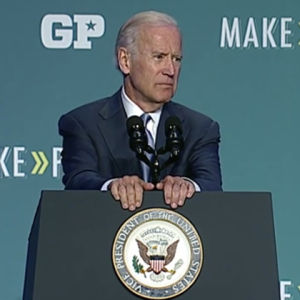The costs of the incoming Biden administration’s climate change policies could fall on the very people liberals are trying to help: low-income families and communities of color.
President-elect Joe Biden has pledged to “move ambitiously to generate clean, American-made electricity to achieve a carbon pollution-free power sector by 2035.” And one of the tools to achieve it is to raise the price of carbon — including gas for your car and heat for your home — to drive down demand. This, critics say, means higher bills for those who can least afford it: seniors on fixed incomes, and families already struggling financially.
“Cost is not an object when it comes to sticking it to the taxpayers,” said Steve Milloy, founder of JunkScience.com. “But it’s a big issue to poor people and seniors and anyone on a pension.”
An obvious example of these forces at work is the Transportation and Climate Initiative supported by Democratic governors in the northeast, as well as Biden during the 2020 campaign. This cap-and-trade plan which was supposed to reach from North Carolina to Maine, could have raised gas prices by as much as 38 cents a gallon in order to reduce emissions and fund green projects. Due in part to those price hikes, just three states (Massachusetts, Rhode Island and Connecticut) and the District of Columbia, entered the compact.
President-elect Joe Biden has said the U.S. will be to rejoin the Paris Climate Treaty on his first day in office. The Heritage Foundation found the Obama administration’s efforts to achieve the treaty’s goals would have cost the average family of four more than $20,000 in lost income, in addition to a loss of nearly 400,000 jobs, about half from the manufacturing sector, and $2.5 trillion in loss to GDP.
Meanwhile, the Paris treaty lacks enforcement mechanisms, so countries like China, which was responsible for 28.5 percent of global emissions in 2018, according to China Power, are free to carry on as before. Between 2000 and 2018, China’s carbon dioxide emissions exceeded those from all European, African, and Latin American countries combined.
“The Paris treaty misleads people into thinking something is getting done, but it’s not,” said Doug Holtz-Eakin, president of American Action Forum.
Holz-Eakin said the Biden Administration’s most likely approach would involve different regulations on various sectors that would eventually destroy any kind of vibrancy in the labor market that is needed to recover from last year’s pandemic lockdowns.
“These regulations have an enormous economic cost in stopping growth,” he said. “The people most likely hurt by them are not the owners of companies who can typically afford them.”
A study by the American Council for an Energy-Efficient Economy found households living 200 percent below the federal poverty level spent nearly four times as much of their income on utility bills as well off families. Black households spend 43 percent more than the white counterparts and Latino households spend 20 percent more.
The Biden campaign was apparently aware of the problem. They posted a page on their website headlined, “The Biden Plan for a Clean Energy Revolution and Environmental Justice.” But that same page pointed to the cap-and-trade policy in California as an example to follow — an effort even many environmentalists agree been a failure.
Mary Nichols, outgoing chair of the California Air Resources Board, was among Biden’s top choices to run the Environmental Protection Agency. More than 70 environmental groups, including several that are based in or have chapters in California, issued a letter strongly opposing her nomination due to her “bleak track record in addressing environmental racism.”
Among their complaints was California’s cap-and-trade plan.
“As warned by environmental justice advocates, cap and trade has increased pollution hotspots for communities of color in California, exacerbating pollution health and safety harms,” the letter read. “ Ms. Nichols and the [resources board], in initially designing the carbon trading system, were fully aware of the disproportionate impacts that cap and trade would have on the health of low-income communities of color. Yet, they championed this strategy that perpetrated environmental racism.”
While policies like cap-and-trade would receive little support from environmental justice advocates and business groups alike on the federal level, a spokesperson for the Climate Justice Alliance disputed claims that overall climate policies would harm lower-income families and other disadvantaged groups.
“We’ve heard this argument for years from the fossil fuel cartels who stand to lose the most in a transition to renewable energy,” said Anthony Rogers-Wright.
Rogers-Wright pointed to the 2035 Report from the Goldman School of Public Policy, University of California Berkley that found that by retaining existing hydropower, nuclear, and natural gas capacity combined with new battery storage, the U.S. can meet 90 percent of the demand for a clean electric grid by 2035. All existing coal plants would be retired over that same period, and no new ones built.
And all of that can be done “dependably, at no extra cost to consumers,” the report claims.
Both Milloy and Holz-Eakin said it is impossible to transition to a green economy without imposing additional costs, taxes and fees, especially on individuals and families at the low ends of the skills and income scales.
Gasoline prices would be the first hit, followed by home electricity costs.
“Gasoline prices affect everything in the economy, especially right now where everything’s done by delivery,” Milloy said. “Most people tend to absorb electricity prices better, but it depends on where you live. If you’re a poor person living in the Northeast, do you decide whether to heat or eat?”

